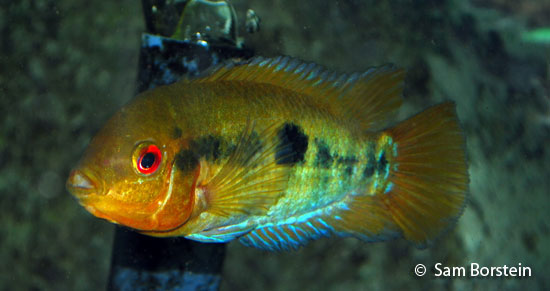Herotilapia multispinosus
(Günther, 1867)
Rainbow Cichlid
Synonyms: Archocentrus multispinosus, Cichlasoma multispinosus

Above: A Rainbow Cichlid. Photo by Sam Borstein.
Etymology:
Genus- Hero= hero (Greek), tilapia= fish (African).
Species- multi= many (Latin), spino= spine (Latin), osa= full (Latin).
Intro:
Rainbow Cichlid is a great cichlid to keep, especially for beginners. This easy hardy, relatively small, and peaceful cichlid is not demanding and is colorful. This fish, first typed by Günther in 1867, belonged in its own genus Herotilapia. After Schmitter-Soto's 2007 reclassification of the Central American fishes this fish was moved to the genus Archocentrus. Although it may be a representative of this genus, very little is known on Rainbow Cichlids scientifically and I believe more research should be done before it is considered a representative of this genus.This fish was first brought into the hobby back in 1961 and is a favorite with many cichlid fanatics.
Distribution:
This fish is found in Costa Rica, Honduras, and Nicaragua where it inhabits rivers and lakes.
Size, Maturity, and Sexual Dimorphism:
Size: Males- 6 inches, Females- 5 inchesMaturity: 2.5 inches
Sexual Dimorphism: Males are larger and may have longer fins. Males also have a steeper head slope.
Care:
Rainbow Cichlids are very peaceful and will rarely go after tank mates. The only aggression I saw from mine was during spawning. The pair bond for this fish is usually strong, so you could keep a pair in a 20 gallon tank, although a 40 breeder would be better. As far as tank mates go, use rainbows or giant danios as these fish can be shy. They also mix well with milder new world cichlids and docile Malawians.
These fish prefer hard water. Chicago Lake Michigan water at a 7.4 pH is fine for them. They can be messy, so keep up with water changes.Diet:
In the wild Rainbow Cichlids eat algae of rocks, but in aquaria they will gladly eat any kind of food offered. I fed mine Spectrum, Tetra Cichlid Sticks, and HBH Graze. The Tetra Cichlid Sticks kept the females in very good breeding condition.
Breeding:
Rainbow Cichlids are super easy to breed. The fish are substrate spawners and will lay eggs on any solid surface in the tank. I like to use rocks and flower pots as breeding sites. When Rainbow Cichlids breed the fish turn jet black with a little bit of orange dorsally. This is awesome to see and as they start to change, exciting because you know they are going to breed.
The fish lay 150-500 eggs on a flat surface. The nest is usually well guarded by the parents. If you have these fish spawn in a community tank, I recommend pulling the eggs and artificially hatching them. These fish have trouble defending against larger, more aggressive fish.
The fry hatch in about 5 days, and are free swimming by 8-9. The fry are small but will gladly eat brine shrimp. Growth is relatively well paced. The fry grow up to about 1 inch in 2 months.
Conclusion:
Rainbow Cichlids are great. I highly recommend them to the cichlid lover who has never tried them, but also to anyone who wants to try cichlids as they are a very nice and peaceful species to start with. This fish is occasionally found in shops and hobbyists. Although it is generally cheap, it tends to disappear from time to time. If you don't have much room and want a nice Central American, give these guys a try.
References:
- Günther, A. (1867) Memoir on the Fishes of the States of Central America, founded upon specimens collected in the fresh and marine waters of various parts of that country by Messrs. Salvin and Godman and Capt. J.M. Dow. Proceedings of the Zoological Society of London, 1866, 600–604.
- Schmitter-Soto, J.J., 2007. A Systematic Revision of the Genus Archocentrus (Perciformes:Cichlidae), with the Description of Two New Genera and Six New Species. Zootaxa 1603, 1-76.
